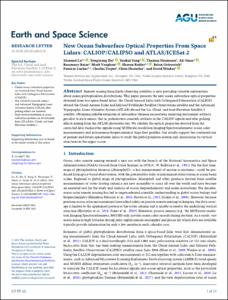| dc.contributor.author | Lu, Xiaomei | |
| dc.contributor.author | Hu, Yongxiang | |
| dc.contributor.author | Yang, Yuekui | |
| dc.contributor.author | Neumann, Thomas | |
| dc.contributor.author | Omar, Ali | |
| dc.contributor.author | Baize, Rosemary | |
| dc.contributor.author | Vaughan, Mark | |
| dc.contributor.author | Rodier, Sharon | |
| dc.contributor.author | Getzewich, Brian | |
| dc.contributor.author | Lucker, Patricia | |
| dc.contributor.author | Trepte, Charles | |
| dc.contributor.author | Hostetler, Chris | |
| dc.contributor.author | Winker, David | |
| dc.date.accessioned | 2021-12-15T20:33:19Z | |
| dc.date.available | 2021-12-15T20:33:19Z | |
| dc.date.issued | 2021 | |
| dc.identifier.citation | Lu, X., Hu, Y., Yang, Y., Neumann, T.,
Omar, A., Baize, R., et al. (2021) New
ocean subsurface optical properties
from space lidars: CALIOP/CALIPSO
and ATLAS/ICESat-2. Earth and Space
Science, 8: e2021EA001839, 13pp. DOI: https://doi.
org/10.1029/2021EA001839 | en_US |
| dc.identifier.uri | https://repository.oceanbestpractices.org/handle/11329/1813 | |
| dc.description.abstract | Remote sensing from Earth-observing satellites is now providing valuable information
about ocean phytoplankton distributions. This paper presents the new ocean subsurface optical properties
obtained from two space-based lidars: the Cloud-Aerosol Lidar with Orthogonal Polarization (CALIOP)
aboard the Cloud-Aerosol Lidar and Infrared Pathfinder Satellite Observations satellite and the Advanced
Topographic Laser Altimeter System (ATLAS) aboard the Ice, Cloud, and land Elevation Satellite-2
satellite. Obtaining reliable estimates of subsurface biomass necessitates removing instrument artifacts
peculiar to each sensor, that is, polarization crosstalk artifacts in the CALIOP signals and after pulsing
effects arising from the ATLAS photodetectors. We validate the optical properties derived from the
corrected lidar backscatter signals using MODerate-resolution Imaging Spectroradiometer ocean color
measurements and autonomous biogeochemical Argo float profiles. Our results support the continued use
of present and future spaceborne lidars to study the global plankton system and characterize its vertical
structures in the upper ocean. | en_US |
| dc.language.iso | en | en_US |
| dc.rights | Attribution-NonCommercial-NoDerivatives 4.0 International | * |
| dc.rights.uri | http://creativecommons.org/licenses/by-nc-nd/4.0/ | * |
| dc.title | New Ocean Subsurface Optical Properties From Space Lidars: CALIOP/CALIPSO and ATLAS/ICESat-2. | en_US |
| dc.type | Journal Contribution | en_US |
| dc.description.refereed | Refereed | en_US |
| dc.format.pagerange | 13pp. | en_US |
| dc.identifier.doi | https://doi. org/10.1029/2021EA001839 | |
| dc.subject.parameterDiscipline | Microzooplankton | en_US |
| dc.subject.parameterDiscipline | Zooplankton | en_US |
| dc.bibliographicCitation.title | Earth and Space Science | en_US |
| dc.bibliographicCitation.volume | 8 | en_US |
| dc.bibliographicCitation.issue | Article e2021EA001839 | en_US |
| dc.description.sdg | 14.a | en_US |
| dc.description.eov | Phytoplankton biomass and diversity | en_US |
| dc.description.eov | Ocean colour | en_US |
| dc.description.sensors | LIDAR | en_US |
| dc.description.methodologyType | Reports with methodological relevance | en_US |
| obps.contact.contactname | X. Lu | |
| obps.contact.contactemail | xiaomei.lu@nasa.gov | |
| obps.resourceurl.publisher | https://agupubs.onlinelibrary.wiley.com/doi/10.1029/2021EA001839 | |
 Repository of community practices in Ocean Research, Applications and Data/Information Management
Repository of community practices in Ocean Research, Applications and Data/Information Management

